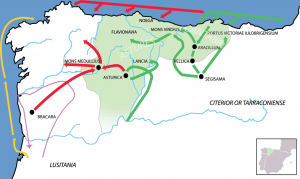The Cantabrian Wars (29-19 BC), also known as the Cantabrian and Asturian Wars, were the final stage of the Roman conquest of Hispania (the Iberian Peninsula). The Cantabri and Astures were the last independent Celtic nations of Hispania and Rome waged a bloody conflict against them during the reign of Emperor Augustus.
First Phase: Bellum Cantabricum (29-25 BC)
The region’s geography was very mountainous and heavily forested, which made it difficult for the Romans to move their troops and supplies. What the Cantabri lacked in forces, they made up for in their knowledge of the terrain. They used guerrilla warfare tactics, such as ambushes and hit-and-run attacks, to great effect against the Romans. Cantabrian warriors used light cavalry, which made them very mobile. They often used short swords and daggers but were also highly skilled in using ranged weapons like spears and javelins.
Their resilience was so great that Augustus was forced to deploy eight legions, namely:
1) I Augusta
2) II Augusta
3) IV Macedonica
4) IX Hispana
5) XX Valeria Victrix
6) V Alaudae (in Asturias)
7) VI Victrix (in Asturias)
8) X Gemina (in Asturias)
and auxiliary units totaling around 20,000 men. Augustus also sent the Roman Navy to the Cantabrian coast from Gallia Aquitania. The navy was an essential part of the Roman campaign as it allowed them to encircle the Cantabri. The Romans were able to block Cantabrian ports to prevent their enemy from getting reinforcements and supplies. In total, Rome deployed about 80,000 men during the conflict.
Second Phase: Bellum Asturicum (25-19 BC)
In 25 BC, Augustus launched his campaign against the Astures, another Celtic tribe located in northwestern Hispania, who allied with the Cantabri in the war. The 3 Roman legions dispatched to Asturias established themselves near the Astura River (modern-day Esla River). The Astures Transmontani, who lived in the mountains, came down and prepared to attack the Roman camps.
Unbeknownst to them, the Brigaecini of the Astures Cismontani, who lived near the coast, had informed Augustus of the plan. As a reward for their help, Augustus gave Brigantum to the Brigaeci. Roman General Publius Carisius then led the surprise attack against the Astur armies. After initial resistance, the Astures were defeated and driven back to their mountain strongholds in Lancia.
Eventually, Lancia was surrounded by Roman troops and fell after a long siege. With the Cantabrian and Asturian Wars at an end after ten years, Rome had finally conquered all of Hispania in 19 BC. However, the brutal tactics employed by the Romans during the conflict hardened public opinion against them. Minor rebellions still occurred and the Roman Empire still had to station two legions in the area for 70 more years.
Pyrrhic Victory for Rome
The end of the conflict was a significant milestone in the history of the Roman Empire, but it was a Pyrrhic victory for them as the cost in lives and resources was very high. The Roman soldiers took no prisoners and the Cantabri even preferred to kill themselves with their own weapons or drink poison rather than be taken as slaves. They created the poison from the seeds of the yew tree, which held a special significance for the Celts as it was seen as a symbol of death and rebirth. For the Cantabri, it was better to die as free men rather than live as slaves.
